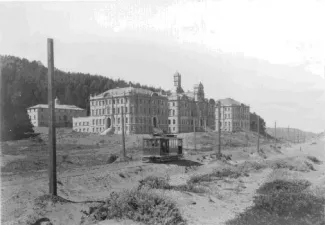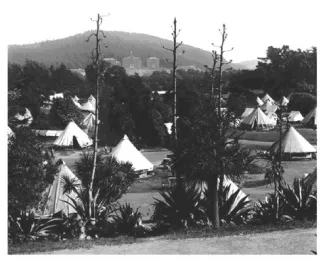Department History
The Department of Surgery at UCSF was established in 1873 by two surgeons, Hugh H. Toland and Richard Beverly Cole who were lured to California by Gold Fever.
By 1852, when Toland crossed the 2,000-mile overland route by wagon train and Cole arrived by steamship, the gold reserves were dwindling, leaving both to resort to surgical careers. Cole became the Dean of the new Medical Department of the University of California, and Toland, the first chairman of the Department of Surgery. In 1898, the school moved to its current location, overlooking Golden Gate Park, on land donated by former San Francisco mayor Adolph Sutro.

Photo of the new Parnassus campus of the UC Medical Department, with streetcar in front.
(Reproduction from Special Collections, The Library, University of California, San Francisco)

After the 1906 earthquake, San Francisco residents took refuge in a tent city in Golden Gate Park. The UCSF campus is on the hill in the background of this photograph
(Reproduction from Special Collections, The Library, University of California, San Francisco)
The Department of Surgery gained national prominence under the leadership of Howard C. Naffziger. After serving as an intern and resident at the University of California Hospital, Naffziger went to Johns Hopkins Hospital in Baltimore to work under William Stewart Halsted and Harvey Cushing, the preeminent surgeons of their day. Naffziger returned to the University of California to teach and develop a first-class surgical center. Nationally renowned for his many contributions to the new specialty of neurosurgery, Naffziger became Chairman of the Department of Surgery in 1929. He developed a residency program modeled after Halsted's and established the first research laboratory on the Parnassus campus. When Naffziger left Surgery in 1947 to chair UC Medical School's new Department of Neurological Surgery, the Halstedian tradition continued under the new Chairman, H. Glenn Bell. Like Naffziger, Bell believed in the importance of the basic sciences to the training of surgeons.

Partial scene from a 1937 mural by Bernard Baruch Zakheim, a student of Diego Rivera's, depicting the history of medicine in California. This scene shows H. Glenn Bell (b 1893, d 1981) performing surgery in the left center foreground.
(Reproduction from Special Collections, The Library, University of California, San Francisco)
His profound interest in surgical pathology was passed on to his many residents, including Edwin "Jack" Wylie, a pioneering giant in vascular surgery, who, in 1951, was the first to perform thromboendarterectomy for atherosclerotic aortoiliac occlusive disease in the United States. The legacy of integrating basic science with surgical training continued under subsequent chairmen (Leon Goldman, 1956-1963, J. Englebert Dunphy, 1964-1975, Paul A. Ebert 1976-1986, Haile Debas 1986-1993, and Theodore Schrock, 1994-1998) and led to many pioneering clinical and research contributions. That legacy grew under the leadership of Nancy L. Ascher, MD, PhD (1999-2016) and Julie Ann Sosa, MD, MA, FACS, FSSO assumed leadership in 2018.
Solid organ transplantation has taken place in patients with HIV, adult live-donor liver transplantation has joined adult to child for transplantation procedures, and a new center for patient-directed breast care has been developed. Other important advances over the last 5 years include the development of a novel endovascular treatment for thoracic and abdominal vascular disease, fetal endoscopic laser treatment of a single arteriovenous communication in twin-twin transfusion syndrome, and initiation of a pancreas islet program. After more than 100 years, the Department of Surgery at UCSF continues to value hard work, productivity, and creativity as it strives to improve surgical techniques, make surgery more effective while less invasive, and improve care for patients.
Other important advances over the last 5 years include the development of a novel endovascular treatment for thoracic and abdominal vascular disease, fetal endoscopic laser treatment of a single arteriovenous communication in twin-twin transfusion syndrome, and initiation of a pancreas islet program.
(Reprinted with permission from the American Medical Association, publishers of Derish P and Ascher NL: The Department of Surgery, University of California, San Francisco 2005;40: 1143-48. Copyright © 2005, American Medical Association. All rights reserved.)
